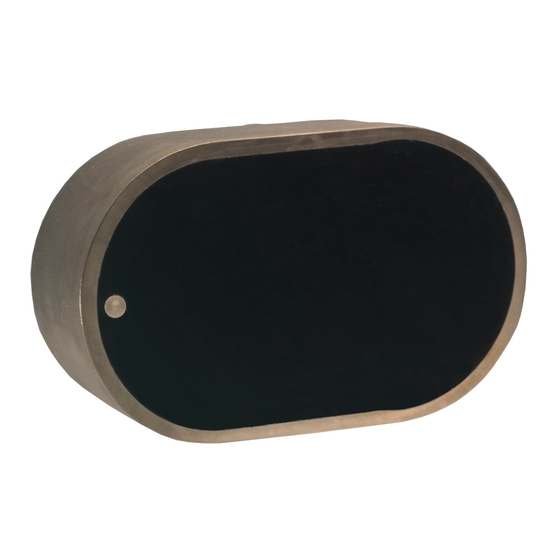Table of Contents
Advertisement
Quick Links
OWNER'S GUIDE & INSTALLATION INSTRUCTIONS
Pocket or Keel Mount:
Chirp Models: PM265LH, PM265LM, PM275LHW
Patent http://www.airmar.com/patent.html
WARNING: The transducer must be professionally installed
using accepted practices. The cavity must be strong and
watertight to reduce the risk of property damage, personal
injury, and/or death.
Follow the precautions below for optimal
product performance and to reduce the risk of
property damage, personal injury, and/or death.
WARNING: Always wear safety glasses, a dust mask,
and ear protection when installing.
WARNING: Use marine sealant to seal the hull and hold
the transducer firmly in place.The bolts are an aid to
Installation only and must not be solely relied upon.
When the boat is underway, especially at high speeds,
water will enter any gaps and push against the
transducer with considerable force.
WARNING: Immediately check for leaks when the boat is
placed in the water. Do not leave the boat unchecked for
more than three hours. Even a small leak may allow
considerable water to accumulate.
CAUTION: Do not install in the engine compartment or
other hot place. The transducer may fail if it overheats.
CAUTION: Always operate the transducer in water.
Operating in air will allow the transducer to overheat
resulting in failure.
CAUTION: The transducer must be flush with the bottom
of the hull for good performance.
CAUTION: Never install a metal housing on a vessel with
a positive ground system.
CAUTION: Never mount a bronze transducer in a metal
hull, because electrolytic corrosion will occur.
CAUTION: Never pull, carry, or hold the transducer by
the cable. This may sever internal connections.
CAUTION: Never strike the transducer.
CAUTION: Never use solvents. Cleaners, fuel, sealant,
paint and other products may contain solvents that can
damage plastic parts, especially the transducer's face.
IMPORTANT: Please read the instructions completely
before proceeding with the installation. These
instructions supersede any other instructions in your
instrument manual if they differ.
1kW
Depth Transducer
with Temperature Sensor
Record the information found on the cable tag for future reference.
Part No._________________Date___________Frequency________kHz
Applications
• Recommended for fiberglass hulls.
• Recommended for high-speed boats.
Tools & Materials
NOTE: Making a fiberglass cavity in the hull requires additional
tools and materials not listed.
Safety glasses
Dust mask
Ear protection
Scissors
Masking tape
Electric drill
Drill bits and hole saws:
Pilot hole for cable
Cable hole
Pilot hole for bolt
Bolt hole (2)
Sandpaper
Mild household detergent or weak solvent
Marine sealant (suitable for below waterline)
Torque wrench
Grommet(s) (some installations)
Cable ties
Water-based anti-fouling paint (mandatory in salt water)
8mm or 5/16"
35mm or 1-3/8"
3mm or 1/8"
11mm or 7/16"
Advertisement
Table of Contents

Summary of Contents for Airmar PM265LH
- Page 1 Record the information found on the cable tag for future reference. Part No._________________Date___________Frequency________kHz Depth Transducer with Temperature Sensor Chirp Models: PM265LH, PM265LM, PM275LHW Patent http://www.airmar.com/patent.html WARNING: The transducer must be professionally installed using accepted practices. The cavity must be strong and watertight to reduce the risk of property damage, personal injury, and/or death.
- Page 2 Figure 1. Best location for the transducer Copyright © 2006 Airmar Technology Corp. Making a Cavity 1. Using the template (page 4), cut along the cutting line for hull Mounting Location cavity (outermost line).
- Page 3 +33.(0)2.23.52.06.48 connector or cutting the cable, except when using water-tight junction box, will void the transducer warranty. email: sales@airmar-emea.com 35 Meadowbrook Drive, Milford, New Hampshire 03055-4613, USA • www.airmar.com Copyright © 2011 - 2019 Airmar Technology Corp. All rights reserved.
- Page 4 IMPORTANT: Some printers and printer settings can alter the size of the template. Verify the template’s size before cutting. Place the transducer on the template to be sure it is the exact size. If necessary, redraw the template. bolt 11mm or 7/16” cable 35mm or 1-3/8”...

















Need help?
Do you have a question about the PM265LH and is the answer not in the manual?
Questions and answers